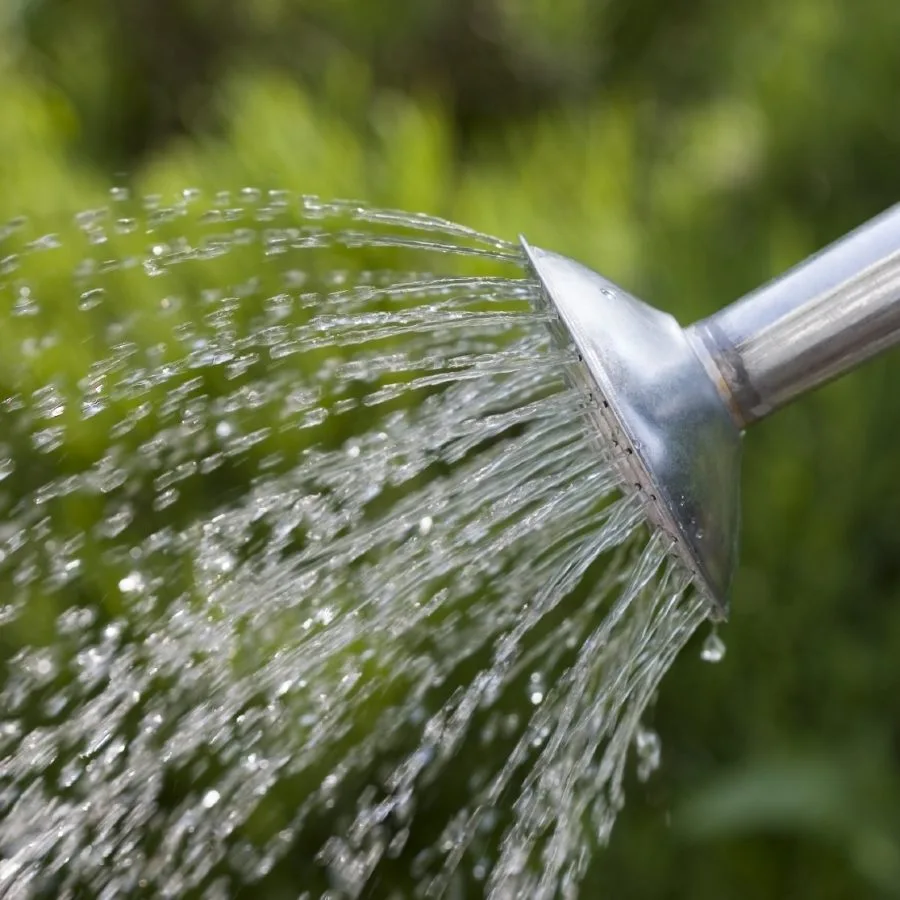Natural State Gardening is a weekly blog about organic gardening techniques.
Why should we water garden plants? Isn’t that what the rain is for?
Yes, but unfortunately, rain is usually not enough. In nature, plants grow where they are best suited to grow – the places with the right amount of water and other conditions – without human interference. We gardeners don’t have the luxury of having the perfect environments for all of the plants we want to grow, so we have to create them. We do this, in part, by amending the soil (as discussed in last week’s post) and by giving each plant the amount of water it prefers. The soil microbes and the plants both need water to live, so it is crucial that we provide them sufficient water.
Watering tools?
Any watering device with a gentle shower will do. Gentle is key; we want to avoid damaging plants – especially seedlings and small plants – and compacting soil. For large gardens and farms, drip irrigation is ideal. For small gardens, watering wands or cans work just fine.
Best time of day for watering?
A couple of hours before sunset is generally the best time to water. This way, the soil will have warmed and, in turn, will warm the cool water before it reaches the plant roots (as to avoid shocking the plant). Late afternoon watering allows more time for the water to soak into the soil and the plant roots overnight, which is when plants do a significant amount of growing. So why not just water at night time? Why a couple of hours before sunset? The sun helps evaporate any water left on the plant’s leaves from watering. Wet leaves can lead to disease.
Morning is less effective, and mid-day is the least effective time for watering due to evaporation.
Where should I spray the water?
Generally, most plants do not like wet leaves. This is especially true for tomatoes, peas, and members of the squash and melon families (cucumbers, gourds, melons, squash, pumpkins) – they are more prone to disease from wet leaves. For these and most other plants, water the soil around the plants – not the leaves, if possible.
However, there is an exception. The cabbage family (broccoli, cauliflower, cabbage, kale, collards, radishes, rutabaga, turnips, mustards) actually prefers to have wet leaves.
How much water?
Water enough to keep the soil evenly moist through the first foot of soil depth. A good way to tell if the soil is evenly moist is to stick your finger deep into the soil. Does it feel evenly moist all the way down? If yes, you probably don’t need to water today. Otherwise, water!
But, how much? It depends on your soil type:
- Sandier soil requires less water to evenly moisten the first foot of soil, as it easily drains. However, it must be watered more frequently.
- Clay soil requires more water to evenly moisten the first foot of soil, as it does not drain well. But, it does not have to be watered as frequently.
The “glimmer test” will help you figure out how much to water. The soil should look shiny for between about 1 to 15 seconds, depending on the soil type; closer to 1 second for sandy soils, closer to 15 seconds for dense clay soils. For the Heights Neighborhood Garden, we have moderately dense soil, so a 5-10 second glimmer is probably about right. If you don’t have time to water deeply, it is probably better not to water that day. We want to encourage deep root growth by watering deeply, so that the plants will be more resilient to drought.
Also, the edges of the beds lose water more quickly than the interior, so water a bit more around the edges.
How often?
Watering frequency depends on a lot of factors: temperature, sun, rain, plant maturity, etc. Generally, though, it is good to water about once a day (or more) during hot weather, and less frequently during cool weather. Again, use the finger test to determine if watering is necessary.
Seedlings and baby plants need frequent watering, often more than once per day. More mature plants may only need watering every other day or so. Some plants, like mature tomato plants, prefer a deep watering only about once per week to promote fruiting. Each plant has its own quirks.
How can I conserve water?
One of the best ways to conserve water and keep plants happy is mulch. A thick layer of mulch around tomato plants, for example, will reduce the amount and frequency of watering by up to 1/3. Mulch can also reduce weeds and keep the soil cooler.
In summation: water gently, deeply, not on the leaves (for most plants), and a couple hours before sunset about once a day or so. Keep the soil evenly moist!



Comments (0)
Thanks for your comment!
Thanks for your feedback! Your comments have been successfully submitted! Please note, all comments require admin approval prior to display.
Error submitting comment!
There is a problem with your comment, please see below and try again.